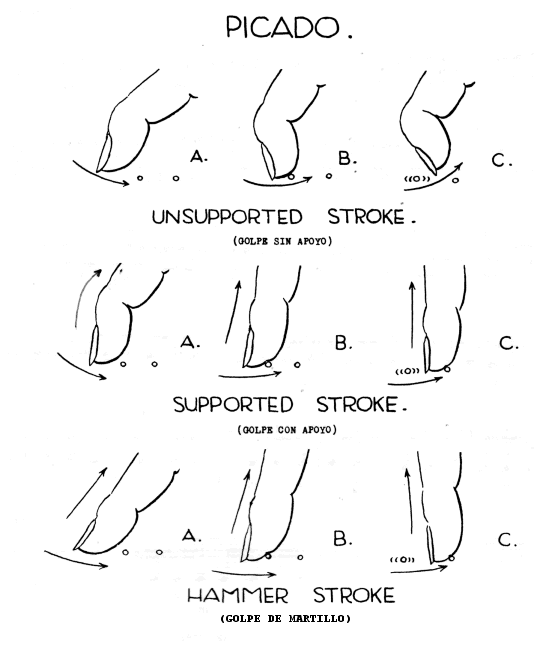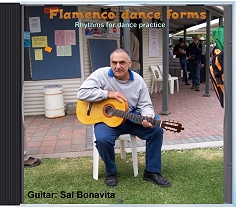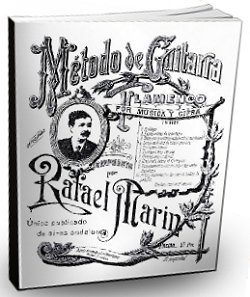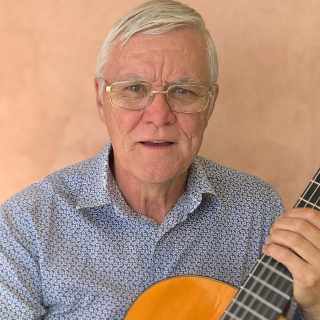The information below is presented here for non-profit educational and research purposes only as allowed for under Section 107 of the Copyright Act (The "Fair Use" provision).
Source:
"El Arte Flamenco" by Jack Buckingham
Copyright 1957, Spanish Music Center, New York City 19, New York
Published by Spanish Music Center, New York City, New York
To my knowledge this book is out of print and may even be in the public domain for all I know. If anyone knows where you can buy this book today please let me know.
Firstly, lets get our definitions right
Picado: Playing single note passages using the alternation or two or more fingers. Strictly speaking, picado can be rest stroke (a supported stroke) or free stroke but is normally associated with the supported stroke.
Finger joints: The first finger joint is the joint nearest the tip of the finger.
PICADO (plucked)
The alternate plucking of the strings with the fingers "Index" (i) and "Medium" (m) of the right hand is called "Picado" (plucked). This technique plays an important part in the execution of the "Falsetas," especially when speed is desired. The general application however differs somewhat from its use in the purely classical idiom. For example, the passages assigned to the bass strings are more often than not played with the thumb (p). Moreover, it is not unusual to find a primitive Flamenco player who prefers the use of the thumb in conjunction with ligado (leagued) for all "Falsetas," even those that fall on solo strings. The more accomplished ones however play equally as well with the thumb as with fingers (i) and (m), alternately. They use the latter system for playing most of the solo string passages.
There are three different techniques for playing the "Picado," and they are as follows:
UNSUPPORTED STROKE:
The finger strikes the string with a semicircular motion. After striking, it follows through with an upward swing which causes it to clear the string below. This method used by many classical guitarists, is practical for Flamenco, although it lacks the power and tonal intensity of the following two.
SUPPORTED STROKE:
This stroke is the most ideal for all types of playing. The finger is'arched at the first joint but straightens as it plays the string,
coming to a gentle rest on the string below.
"MARTILLO" (Hammer or snap stroke):
This offshoot of the supported stroke is a favorite of many Flamenco guitarists, mainly because it produces the great amount of volume necessary for the guitar to be. heard above the "Cuadro Flamenco" (singers and dancers with castanets). The finger is held straight, and plays the string by literally snapping it off of the finger tip. Following through it is brought to rest rather forcefully, against the string below.
Summary
Those who can master the supported stroke will find that when the occasion demands it, they have the added advantage of being able to change to the hammer stroke with little or no effort, sometimes a life saver for the Flamenco artist. In any event, the superior tone and ease of execution that is realized by using the supported stroke, even in classical playing, will more than justify the time one takes to learn it.
Study the three illustrations of the "Picado" below. Notice the fingering of the descending scale where it changes to a lower string. The arrows point out where the finger moving down from the string above, plucks the lower string instead of coming to rest there. Full advantage should be taken of these intervals when they occur, for they make possible the speed demanded by the faster moving "Falsetas."






